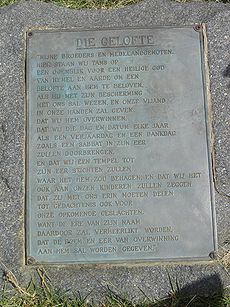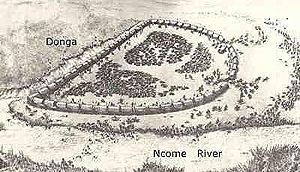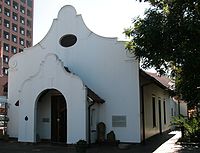
Day of the Vow
Encyclopedia

The Day of the Vow is the name of a religious public holiday in South Africa
South Africa
The Republic of South Africa is a country in southern Africa. Located at the southern tip of Africa, it is divided into nine provinces, with of coastline on the Atlantic and Indian oceans...
until 1994, when it was renamed the Day of Reconciliation
Day of Reconciliation
The Day of Reconciliation is a public holiday in South Africa held annually on 16 December. The holiday came into effect in 1994 after the end of apartheid, with the intention of fostering reconciliation and national unity...
. The holiday is December 16. Commemorating a famous Boer
Boer
Boer is the Dutch and Afrikaans word for farmer, which came to denote the descendants of the Dutch-speaking settlers of the eastern Cape frontier in Southern Africa during the 18th century, as well as those who left the Cape Colony during the 19th century to settle in the Orange Free State,...
victory over the Zulu, the anniversary and its commemoration are intimately connected with various streams of Afrikaner nationalism
Afrikaner nationalism
Afrikaner nationalism is a political ideology that was born in the late 19th century around the idea that Afrikaners in South Africa were a "chosen people"; it was also strongly influenced by anti-British sentiments that grew strong among the Afrikaners, especially because of the Boer Wars...
.
Origin

Afrikaner
Afrikaners are an ethnic group in Southern Africa descended from almost equal numbers of Dutch, French and German settlers whose native tongue is Afrikaans: a Germanic language which derives primarily from 17th century Dutch, and a variety of other languages.-Related ethno-linguistic groups:The...
tradition, the Day of the Vow traces its origin as an annual religious holiday to The Battle of Blood River on 16 December 1838. The besieged Voortrekkers took a public vow (or covenant) together before the battle, led by either Andries Pretorius
Andries Pretorius
Andries Wilhelmus Jacobus Pretorius was a leader of the Boers who was instrumental in the creation of the Transvaal Republic, as well as the earlier but short-lived Natalia Republic, in present-day South Africa....
or Sarel Cilliers
Sarel Cilliers
Charl Arnoldus Cilliers was a Voortrekker leader and a preacher. With Andries Pretorius, he led the Boers to a huge victory over the Zulus at the Battle of Blood River in 1838...
, depending on whose version is correct. In return for God's help in obtaining victory, they promised to build a monument, and also vowed that they and their descendants would keep the day as a holy Sabbath. During the battle a group of about 470 Voortrekkers
Voortrekkers
The Voortrekkers were emigrants during the 1830s and 1840s who left the Cape Colony moving into the interior of what is now South Africa...
defeated a force of about ten thousand Zulu. Only three Voortrekkers were wounded, and some 3,000 Zulu warriors died in the battle.
Two of the earlier names given to the day stem from this prayer. Officially known as the Day of the Vow, the commemoration was renamed from the Day of the Covenant in 1982. Afrikaners colloquially referred to it as Geloftedag, or Dingaansdag (Dingane's Day), a reference to the Zulu ruler of the defeated attackers.
Wording
No verbatim record of the vow exists. The version often considered to be the original vow is in fact W.E.G. Louw's ca. 1962 translation into Afrikaans of G.B.A. Gerdener's reconstruction of the vow in his 1919 biography of Sarel Cilliers (Bailey 2003:25).The wording of the Vow is:
History

Battle of Blood River
The Battle of Blood River, so called due to the colour of water in the Ncome River turning red with blood, was fought between 470 Voortrekkers led by Andries Pretorius, and an estimated 10,000–15,000 Zulu attackers on the bank of the Ncome River on 16 December 1838, in what is today KwaZulu-Natal,...
) which bound future descendants to commemorate the day as a religious holiday (sabbath) in the case of victory over the Zulu. In 1841 the victorious Trekkers built The Church of the Vow at Pietermaritzburg, and passed the obligation to keep the vow on to their descendants.
As the original vow was never recorded in verbatim form, descriptions come from the diary of Jan Bantjes (possibly written on December 9); a dispatch written by Pretorius to the Volksraad
Volksraad
The Volksraad was the parliament of the former South African Republic , which existed from 1857 to 1902 in part of what is now the South Africa. The body ceased to exist after the British victory in the Second Anglo-Boer War. The Volksraad sat in session in Ou Raadsaal in Church Square, Pretoria...
on December 23, 1838; and the recollections of Sarel Cilliers in 1871. A participant in the battle, Dewald Pretorius, wrote his recollections in 1862, interpreting the vow as including the building of churches and schools (Bailey 2003:31).
Jan B. Bantjes (1817–1887), Pretorius' secretary, indicates that the initial promise was to build a House in return for victory. He notes that Pretorius called everyone together, and asked them to pray for God's help. Bantjes writes that Pretorius told the assembly that he wanted to make a vow, "if everyone would agree" (Bailey 2003:24). Bantjes does not say whether everyone did so. Perhaps the fractious nature of the Boers dictated that the raiding party held their own prayers in the tents of various leading men (Mackenzie 1997:73). Pretorius is also quoted as wanting to have a book written to make known what God had done to even "our last descendants".
Pretorius in his 1838 dispatch mentions a vow in connection with the building of a church, but not that it would be binding for future generations.
Contrary to Pretorius, and in agreement with Bantjes, Cilliers in 1870 recalled a promise , not a vow, to commemorate the day and to tell the story to future generations. Accordingly, they would remember:
Cilliers writes that those who objected were given the option to leave. At least two persons declined to participate in the vow. Scholars disagree about whether the accompanying English settlers and servants complied (Bailey 2003). This seems to confirm that the promise was binding only on those present at the actual battle. Mackenzie (1997) claims that Cilliers may be recalling what he said to men who met in his tent.
Up to the 1970s the received version of events was seldom questioned, but since then scholars have questioned almost every aspect. They debate whether a vow was even taken and, if so, what its wording was. Some argue that the vow occurred on the day of the battle, others point to December 7 or 9. Whether Andries Pretorius or Sarel Cilliers led the assembly has been debated; and even whether there was an assembly. The location at which the vow was taken has also produced diverging opinions, with some rejecting the Ncome River site for (Bailey 2003).
Commemorations of the Day of the Vow
Disagreements exist about the extent to which the date was commemorated before the 1860s. Some historians maintained that little happened between 1838 and 1910. Historian S.P. Mackenzie argues that the day was not commemorated before the 1880s. Initial observations may have been limited to those associated with the battle at Ncome River and their descendants. While Sarel Cilliers upheld the day, Andries Pretorius did not (Ehlers 2003).In Natal
Informal commemorations may have been held in the homes of former Voortrekkers in Pietermaritzburg in Natal. Voortrekker pastor Rev. Erasmus Smit announced the "7th annual" anniversary of the day in 1844 in De Natalier newspaper, for instance. Bailey mentions a meeting at the site of the battle in 1862 (Bailey 2003:29,32).In 1864 the General Synod of the Dutch Reformed Church
Dutch Reformed Church
The Dutch Reformed Church was a Reformed Christian denomination in the Netherlands. It existed from the 1570s to 2004, the year it merged with the Reformed Churches in the Netherlands and the Evangelical Lutheran Church in the Kingdom of the Netherlands to form the Protestant Church in the...
in Natal decreed that all its congregations should observe the date as a day of thanksgiving. The decision was spurred by the efforts of two Dutch clergymen working in Pietermaritsburg during the 1860s, D.P.M. Huet and F. Lion Cachet. Large meetings were held in the church in Pietermaritzburg in 1864 and 1865 (Bailey 2003:33).
In 1866 the first large scale meeting took place at the traditional battle site, led by Cachet. Zulus who gathered to watch proceedings assisted the participants in gathering stones for a commemorative cairn. In his speech Cachet called for the evangelization of black heathen. He relayed a message received from the Zulu monarch Cetshwayo. In his reply to Cetshwayo, Cachet hoped for harmony between the Zulu and white Natalians. Trekker survivors recalled events, an institution which in the 1867 observation at the site included a Zulu (Bailey 2003:35).
Huet was of the same opinion as Delward Pretorius. He declared at a church inauguration in Greytown on December 16, 1866 that its construction was also part of fulfilling the vow (Bailey 2003:35).
In the Transvaal
Die Zuid-Afrikaansche Republiek declared 16 December a public holiday in 1865, to be commemorated by public religious services. However, until 1877, the general public there did not utilize the holiday as they did in Natal. Cricket matches and hunts were organized, some businesses remained open, and newspapers were sold. The name Dingane's Day appeared for the first time in the media, in an 1875 edition of De Volksstem. That newspaper wondered whether the lack of support for the holiday signaled a weakening sense of nationalism (Bailey 2003:37,38).After the Transvaal was annexed by the British in 1877, the new government refrained from state functions (like Supreme Court sittings) on the date (Bailey 2003:41).
The desire by the Transvaal to retrieve its independence prompted the emergence of Afrikaner nationalism and the revival of December 16 in that territory. Transvaal burgers held meetings around the date to discuss responses to the annexation. In 1879 the first such a meeting convened at Wonderfontein on the West Rand. Burgers disregarded Sir G.J. Wolseley, the governor of Transvaal, who prohibited the meeting on December 16. The following year they held a similar combination of discussions and the celebration of Dingane's Day at Paardekraal (Bailey 2003:43).
Paul Kruger
Paul Kruger
Stephanus Johannes Paulus Kruger , better known as Paul Kruger and affectionately known as Uncle Paul was State President of the South African Republic...
, president of the Transvaal Republic, believed that failure to observe the date led to the loss of independence and to the first Anglo-Boer war as a divine punishment. Before initiating hostilities with the British, a ceremony was held at Paardekraal on December 16, 1880 in which 5,000 burghers [citizens] piled a cairn of stones that symbolized past and future victories (over the Zulu and the British).
After the success of its military campaign against the British, the Transvaal state organized a Dingane's Day festival every five years. At the first of these in 1881, an estimated 12,000 to 15,000 people listened to speeches by Kruger and others (Gilliomee 1989). At the third such festival in 1891, Kruger emphasized the need for the festival to be religious in nature (Ehlers 2003).
In the Free State
The Free State government in 1894 declared December 16 a holiday (Bailey 2003).National commemorations
The Union state in 1910 officially declared Dingane's Day as a national public holiday.In 1938 D.F. Malan, leader of the National Party, reiterated at the site that its soil was "sacred." He said that the Blood River battle established "South Africa as a civilized Christian country" and "the responsible authority of the white race". Malan compared the battle to the urban labour situation in which whites had to prevail (Ehlers 2003).
In 1952 the ruling National Party passed the Public Holidays Act (Act 5 of 1952), in which section 2 declared the day to be a religious public holiday. Accordingly, certain activities were prohibited, such as organized sports contests, theatre shows, and so on (Ehlers 2003). Pegging a claim on this day was also forbidden under section 48(4)(a) of the Mining Rights (Act 20 of 1967; repealed by the Minerals Act (Act 50 of 1991).http://findarticles.com/p/articles/mi_qa3736/is_199901/ai_n8832379/pg_19
The name was changed to the Day of the Vow in order to be less offensive, and to emphasize the vow rather than the Zulu protagonist (Ehlers 2003).
In 1961 the African National Congress chose December 16 to initiate a series of sabotages, signaling its decision to embark on an armed struggle against the regime through its military wing, Umkhonto we Sizwe
Umkhonto we Sizwe
Umkhonto we Sizwe , translated "Spear of the Nation," was the armed wing of the African National Congress which fought against the South African apartheid government. MK launched its first guerrilla attacks against government installations on 16 December 1961...
.
In 1983 the South African government vetoed the decision by the acting government of Namibia
Namibia
Namibia, officially the Republic of Namibia , is a country in southern Africa whose western border is the Atlantic Ocean. It shares land borders with Angola and Zambia to the north, Botswana to the east and South Africa to the south and east. It gained independence from South Africa on 21 March...
to discontinue observing the holiday. In response, the Democratic Turnhalle Alliance resigned its 41 seats in Namibia's 50-seat National Assembly.
Act 5 of 1952 was repealed in 1994 by Act No. 36 of 1994, which changed the name of the public holiday to the Day of Reconciliation.
The Truth and Reconciliation Commission started its work on December 16, 1995.
Debates Over the Holiday
Those who celebrate the holiday argue that commemoration has nothing to do with racial dynamics; they are simply remembering to give thanks for divine deliverance from certain destruction. Detractors from this viewpoint claim that the victors were of one and the defeated from another race and that celebrating the breaking of the power of a Zulu tyrant creates racial tension. Yet others point out that the defeated Zulu leader, Dingane, was in fact a usurper of the throne who murdered the famous King Shaka; that the ultimate victors of the greater conflict were an alliance of Boers and a Shaka loyalist Zulu force led by Prince Mpande, who was the rightful heir; and that consequently, it is illegitimate to politicize the events at all, whether in a nationalist or liberal sense.Scholars like historian Leonard Thompson have said that the events of the battle were woven into a new myth that justified racial oppression on the bases of racial superiority and divine providence. Accordingly, the victory over Dingaan was reinterpreted as a sign that God confirmed the rule of whites over black Africans, justifying the Boer
Boer
Boer is the Dutch and Afrikaans word for farmer, which came to denote the descendants of the Dutch-speaking settlers of the eastern Cape frontier in Southern Africa during the 18th century, as well as those who left the Cape Colony during the 19th century to settle in the Orange Free State,...
project of acquiring land and eventually ascending to power in South Africa. In post-apartheid South Africa the holiday was criticized as a racist holiday, which celebrates the success of Boer expansion over the black natives.
By comparison with the large number of Afrikaners who participated in the annual celebrations of the Voortrekker victory, some did take exception. In 1971, for instance, Pro Veritate, the journal of the anti-apartheid organization the Christian Institute of Southern Africa
Christian Institute of Southern Africa
The Christian Institute of Southern Africa was an ecumenical progressive organisation founded by English and Afrikaans clergy in December 1963 to unite South African Christians against apartheid...
, devoted a special edition to the matter.
Historian Anton Ehlers traces how political and economic factors changed the themes emphasized during celebrations of the Day of the Vow. During the 1940s and 1950s Afrikaner unity was emphasized over against black Africans. This theme acquired broader meaning in the 1960s and 1970s, when isolated "white" South Africa was positioned against the decolonization of Africa. The economic and political crises of the 1970s and 1980s forced white Afrikaners to rethink the apartheid system. Afrikaner and other intellectuals began to critically evaluate the historical basis for the celebration. The need to include English and "moderate" black groups in reforms prompted a de-emphasis on "the ethnic exclusivity and divine mission of Afrikaners" (Ehlers 2003).
External links
- Official WebSite of the Bloodriver Vow Committee, Bloedrivier Gelofteherdenkingskomitee
- The Battle of Blood River, South African Travel Guide
- Public holidays in South Africa

